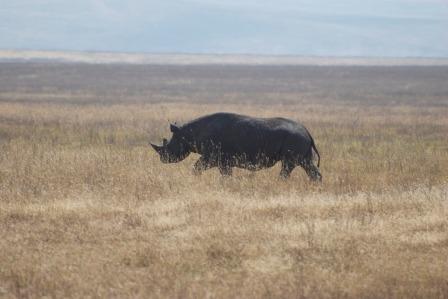Rhinoceros – a ‘Near Threatened’ and ‘Critically Endangered’ Species Due to Man

The black rhinoceros falls under the ‘Critically Endangered’ On the IUCN Red List of Threatened species.
Commonly called rhinos, these huge animals are getting much more difficult to spot when on African safaris. Out of the five remaining species of rhinoceros in the world, two are found in Africa and three are found in Asia.
The African rhinoceros has two big horns – one on the nose and one on the mid-forehead. Made of keratin, these horns grow out of the skin. It is the second largest animal in Africa, after the elephants.
Types
There are two types of rhinoceros found in Africa:
- Square-lipped or White Rhinoceros (Ceratotherium simum) – grey in color and with a prominent square lip, it is larger but less aggressive than the black rhinoceros. It has a distinguishable hump on the back of its neck and a large head. It can crop large mouthfuls of grass and for this, it prefers grasslands and savanna. It can coexist in groups of 12 or less. It has a wide range of vocalization and can communicate by rubbing against each other when in good mood!
- Hook-Lipped or Black Rhinoceros (Diceros bicornis) – more rare than the white rhinoceros, it is grey in color and has a pointed mouth with a hooked lip. It prefers woody and dense vegetation but can adjust to other habitats as well. It loves to wallow in waterholes and stay in water and mud for hours to keep itself cool. It needs to drink fresh water frequently and so, visits the same waterhole daily and becomes an easy target of the poacher(s).
Profile
A brief profile of the rhinoceros is as follows:
- It is roughly 60 inches tall.
- Black rhinoceros weighs between 1,760 lb and 2,970 lb whereas the white rhinoceros weighs between 3,960 lb and 5,640 lb.
- It lives up to 35-40 years in captivity.
- It prefers a habitat of grasslands and savannas/woody and dense vegetation.
- It is typically herbivorous.
- Its gestation period is about 16 months.
- It is a target to the humans.
Habitat
White rhinoceros prefers grassland and savanna; black rhinoceros prefers woody and dense vegetation and can adjust with any other habitat. Both prefer waterholes, shady trees and mud wallows to be nearby.
Food Habits
White Rhinoceros eats only grass; black rhinoceros eats leaves, buds and shoots of plants/trees.
Size and Lifespan
The white rhinoceros is 60 inches in height and weighs between 3960 lb and 5640 lb. The black rhinoceros is 54 inches to 66 inches in height and weighs between 1760 lb and 2970 lb. The white rhinoceros lives for about 50 years; the black rhinoceros lives between 35 to 40 years in captivity and between 30 to 35 years in the open.
Reproduction
One calf born every 2 to 3 years, the gestation period of white rhinoceros is about 16 months. One calf born every 2.5 to 4 years, the gestation period of black rhinoceros is between 15-month and 16-month. A calf lives with the mother for about 2 to 4 years.
Predators
The rhinoceros is the target of the humans, mostly for its horns.
Threat
The horns of the rhinoceros are used to make the handles for Djambia daggers and as a febrifuge in Chinese medicine. On the IUCN Red List of Threatened species, the black rhinoceros falls under the ‘Critically Endangered’ status and the white rhinoceros falls under the ‘Near Threatened’ status.



